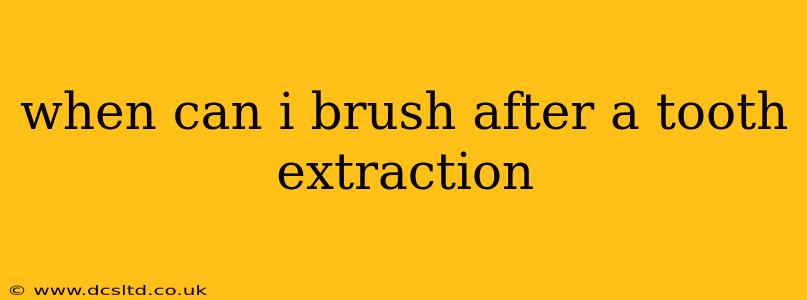Having a tooth extracted can be a stressful experience, and knowing when you can resume your normal oral hygiene routine is a common concern. This guide will clarify when you can brush your teeth after an extraction and provide essential tips for post-operative care to ensure a smooth recovery. Remember, always follow your dentist's specific instructions, as recovery times can vary depending on the complexity of the extraction.
How Soon Can I Brush After a Tooth Extraction?
The short answer is: wait until the bleeding has stopped and the blood clot has formed. This usually takes several hours, but it could be longer. Rushing the process could dislodge the blood clot, leading to a painful and potentially serious complication called dry socket.
Your dentist will likely provide specific instructions, but generally, you can start gently brushing the area 24 to 48 hours after the extraction. Focus on the areas away from the extraction site for the first few days.
What Should I Do Immediately After a Tooth Extraction?
Following your dentist's post-operative instructions is crucial for a successful recovery. Immediate steps usually include:
- Applying pressure: Bite down firmly on a gauze pad placed over the extraction site to control bleeding.
- Ice packs: Apply ice packs to the cheek to reduce swelling.
- Rest: Rest and avoid strenuous activity.
- Avoid rinsing: Avoid rinsing vigorously or spitting for the first 24 hours, as this can dislodge the blood clot.
Can I Brush My Other Teeth After a Tooth Extraction?
Yes, you should continue to brush your other teeth as you normally would, twice a day, to maintain good oral hygiene and prevent infection. However, as mentioned earlier, avoid brushing near the extraction site until your dentist gives you the go-ahead.
How Should I Brush After a Tooth Extraction?
When you do start brushing near the extraction site, use a soft-bristled toothbrush and be extremely gentle. Avoid vigorous brushing or scrubbing. Use gentle circular motions, focusing on cleaning the surrounding teeth.
What If I Get a Dry Socket?
Dry socket (alveolar osteitis) is a painful complication that can occur when the blood clot at the extraction site becomes dislodged. Symptoms include severe pain, a bad taste in your mouth, and a visible empty socket. If you suspect you have a dry socket, contact your dentist immediately. They can provide pain relief and treatment.
What Other Oral Hygiene Practices Should I Follow?
Besides brushing, maintaining good oral hygiene includes:
- Gentle rinsing: Once your dentist approves, you can rinse your mouth gently with salt water (a teaspoon of salt in a cup of warm water) to help keep the area clean.
- Avoid smoking: Smoking significantly increases the risk of dry socket and impedes healing.
- Avoid using straws: Straws can create suction, dislodging the blood clot.
- Eat soft foods: Focus on soft, nutritious foods during the healing period to avoid irritating the extraction site.
When Can I Use Mouthwash After a Tooth Extraction?
Similar to brushing, you should wait until the bleeding has stopped and the blood clot has formed before using mouthwash. When you do use mouthwash, use a gentle, alcohol-free variety. Always check with your dentist for their specific recommendations.
Remember, this information is for general guidance only. Always consult your dentist or oral surgeon for personalized post-operative instructions tailored to your specific situation. Their expertise is crucial for ensuring a smooth and complication-free recovery.
